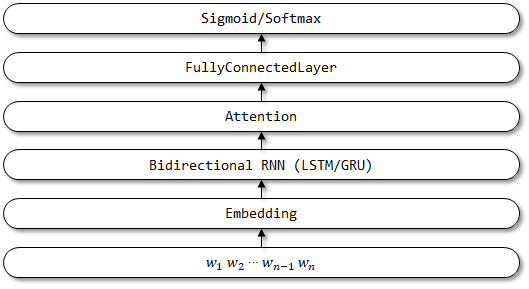BiRNN+Attention
完整代码在github
此处对于注意力机制的实现参照了论文 Feed-Forward Networks with Attention Can Solve Some Long-Term Memory Problems
此处实现的网络结构:

基于tensorflow2.0的keras实现
自定义 Attention layer
这是tensorflow2.0推荐的写法,继承Layer,自定义Layer
需要注意的几点:
- 如果需要使用到其他Layer结构或者Sequential结构,需要在init()函数里赋值
- 在build()里面构建权重参数, 每个参数需要赋值name
- 如果参数不给name,当训练到第2个epoch时会报错:AttributeError: ‘NoneType’ object has no attribute ‘replace’
- 在call()里写计算逻辑
- 这里实现的Attention是将GRU各个step的output作为key和value,增加一个参数向量W作为query,主要是为了计算GRU各个step的output的权重,最后加权求和得到Attention的输出
1 | # -*- coding: utf-8 -*- |
自定义Model 构建
- 其中可以注意的是:允许定义Sequential来包裹常用block,比如下面的 point_wise_feed_forward_network()函数,包裹了n个全连接层。然后在自定义模型的init()里初始化使用
1 | # -*- coding: utf-8 -*- |